The best 25 CD players of What Hi-Fi?'s lifetime
The finest CD players What Hi-Fi? has reviewed since the format took off in 1983
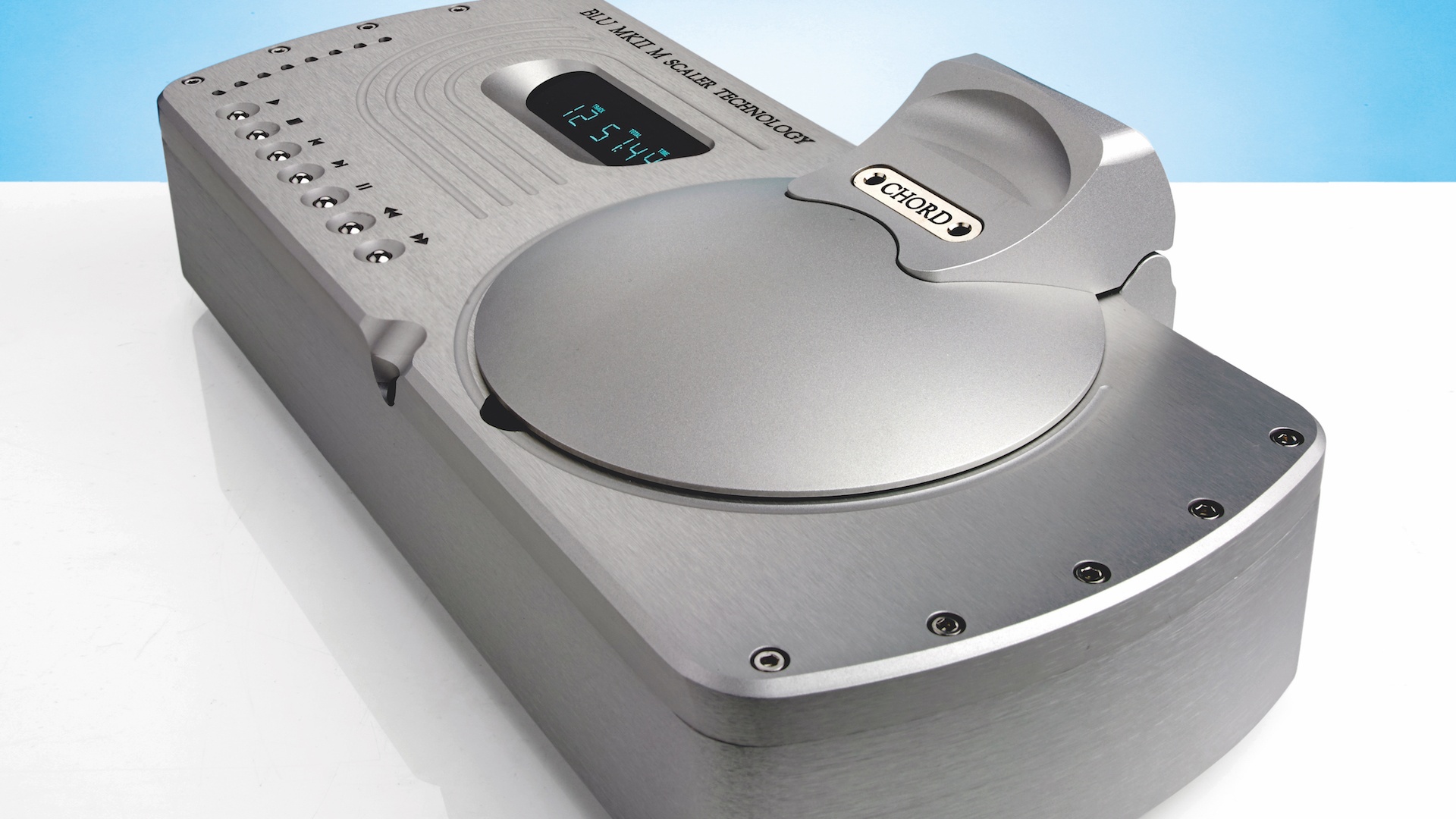
Though not the first digital optical disc format (that would be Laserdisc), Compact Disc blazed a digital trail into the mainstream long before streaming and high-resolution audio become industry buzzwords.
Launched 40 years ago (it celebrated its 40th anniversary in October), the CD was originally promoted with the slogan "Perfect Sound Forever". It never quite lived up to that lofty claim, but it has had a significant impact on the world of hi-fi – and continues to do so, offering the tactility that streaming doesn't and the affordability over vinyl.
This list celebrates the best disc spinners we've had the pleasure of reviewing over the past four decades...
- The best CD players you can buy right now
- How to get the best sound from your CD player
Philips CD100 (1983)
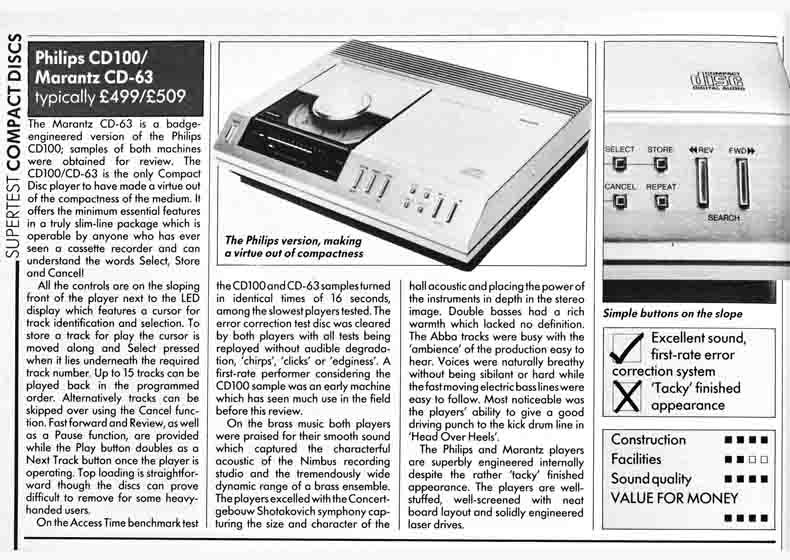
Most early CD players adopted Sony's 16-bit standard, but Philips stuck with its 14-bit system. The Dutch company bridged the gap with an approach called 'oversampling'.
Three extra samples of the original signal were created. These were then fed into the DAC at four times the original rate, cleverly matching the resolution of 16-bit in the process.
It wasn't the only player to do this. Marantz's CD-63 was a badge-engineered CD100, and both ably captured a track's size and character.
For a first-generation effort, it wasn't the most striking in terms of appearance. But the sound was naturally smooth, and the error correction first-rate.
Get the What Hi-Fi? Newsletter
The latest hi-fi, home cinema and tech news, reviews, buying advice and deals, direct to your inbox.
Sony CDP-101 (1983)
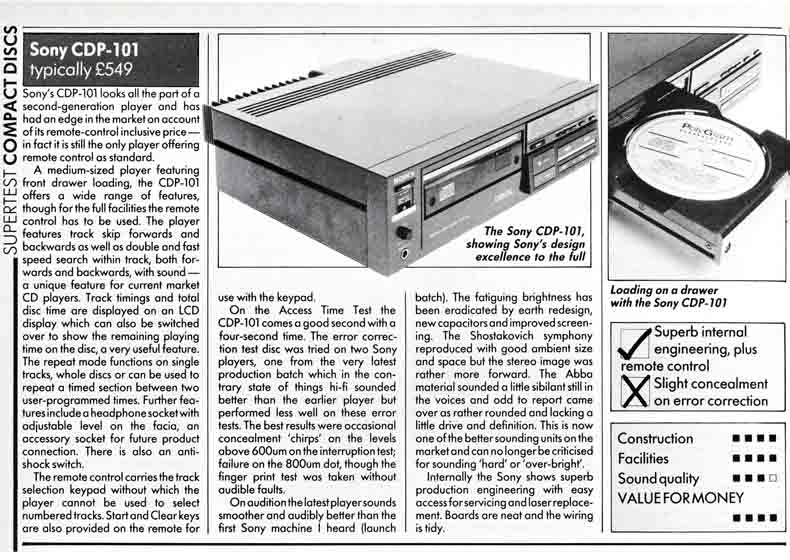
The CDP-101 showed Sony getting to grips with the CD format right from the off.
It had things we'd take for granted now. The remote came as standard, and you could fast-speed search both forwards and backwards. Plus it had an LCD display and a headphone output.
The launch batch of the CDP-101 delivered a hard and bright performer. It was further tweaked, the sound becoming smoother and more detailed.
Factor in Sony's design nous and its robust build, and the CDP-101 was a promising glimpse of the future.
Meridian MCD (1985)
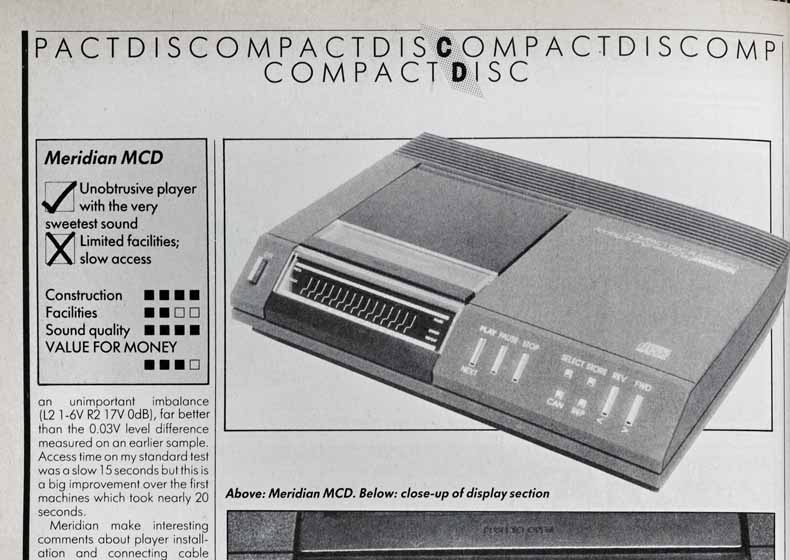
The MCD bore a striking resemblance to Philips' CD100/CD101 players.
Meridian took the shell of Philips' player and painted it graphite grey. However, the MCD's innards were a different matter. The output stages were rebuilt, and the servo and error-correction systems were tinkered with.
This resulted in a player with a sweet and musical sound, tidy with low frequencies and good with scale. Like many early efforts, it had basic features (no remote, for instance), but the sound was its main appeal.
Cambridge CD1 (1986)

Cambridge Audio's CD1 cost a fortune when it launched in 1986 for £1500, which is about £5000 / $6000 / AU$9000 in today's money. It was double, if not triple, the price of most other players at the time.
Made up of two separate boxes, the upper half was where the disc tray and power supply were located. The bottom half housed the DAC.
Similar to the CD100, it featured three 14-bit DACs (with oversampling) per channel. Two worked together for speed and accuracy, while the third smoothed out any errors.
It helped produce a soundstage with great depth and space, able to dig out hidden and low-level information with ease. The price was steep, but it was head and shoulders above other players at the time.
Philips CD850 (1990)
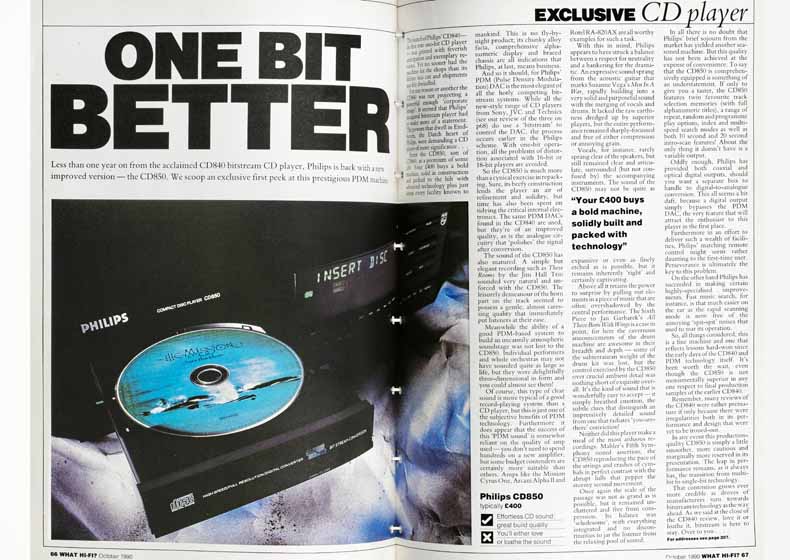
The CD850 quickly replaced the CD840 and, though it was similar, it was much more than just a cynical repackaging.
It was a solidly built machine, full of (for its time) advanced technology such as Philip's own PDM (Pulse Density Modulation) bit-stream DAC.
The sound had matured from the CD840, resulting in a natural and unforced performance and a soundstage that was "uncannily atmospheric".
It was not the most convenient of players, but it offered an effortless CD sound.
Meridian 200/203 DAC (1991)
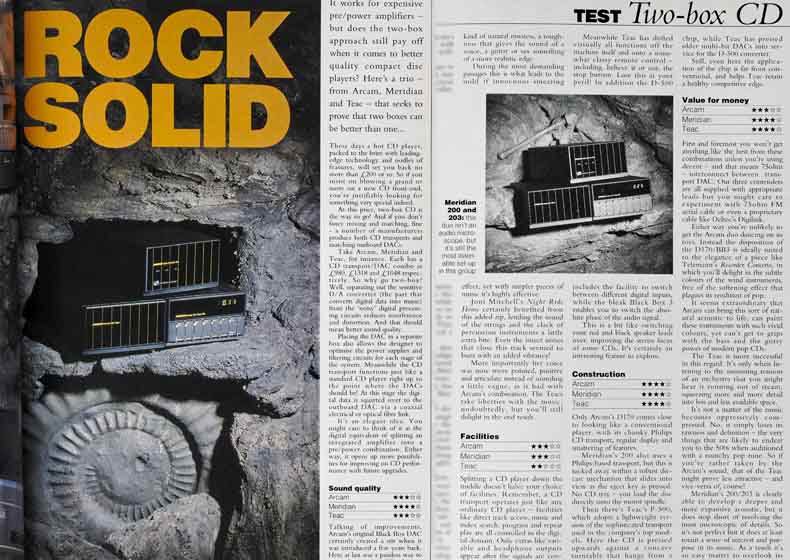
We found Meridian's 200 CD transport to have a "distinctly extrovert" sound when we first heard it in 1991.
The soundstage was wider, deeper and more forward than its peers. It was bold in how it attacked a piece of music and was capable of handling busy tracks without tripping over itself.
It was excellent on its own and even better when partnered with the 203 DAC. The clarity of the 200 was a good match for the warmer sensibilities of the 203, and together they made an impressively musical sound.
Rotel RCD-965BX (1991)
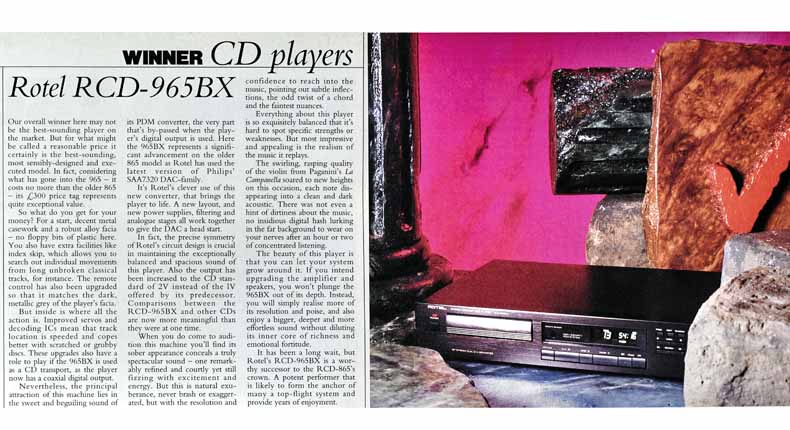
The success of Rotel's budget player was down to a number of factors.
It was an effortless, natural and convincing performer, and it could slot into the most modest of systems without fuss.
It was also unencumbered by too many features – just the bare essentials and not much more. More was found under the hood, with a new bitstream DAC as well as an excellent circuit design.
The attention to detail Rotel afforded the RCD-965BX resulted in a unit that wasn't flashy but extracted as much as it could from a piece of music. No player in the budget arena at the time could match its qualities.
Marantz CD-52 MkII SE (1993)
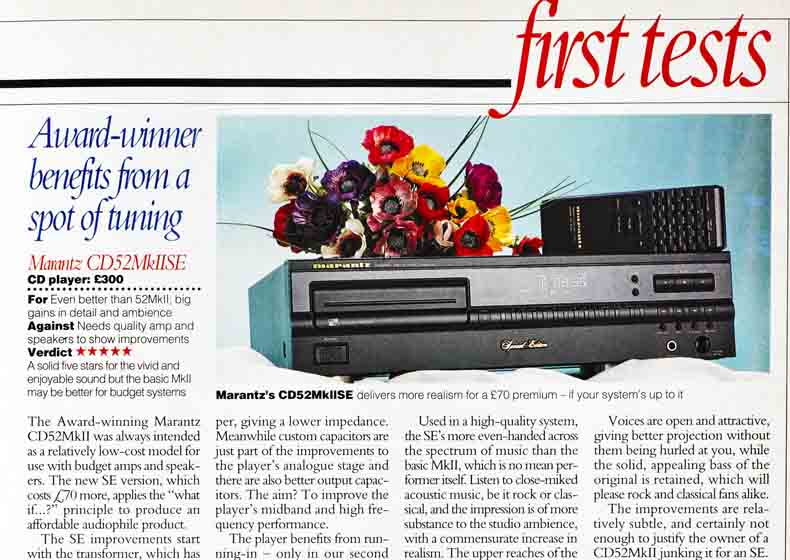
There were more versions of the CD-52 than you could shake a stick at, but a strong case could be made for the MkII SE being the best of the lot.
The MkII was essentially an audiophile player for the budget market. Inside was a transformer that could carry a higher current, along with several high-spec components in the analogue and output stages.
It retained the MkII's core of detail, weight and agile bass. Notable improvements could be felt in the upper midrange and treble – voices and solo instruments hit with much more of an impact.
It conjured up a vivid and detailed sound at a sensible price, a trait the company still excels at today.
Technics SL-PG480 (1996)
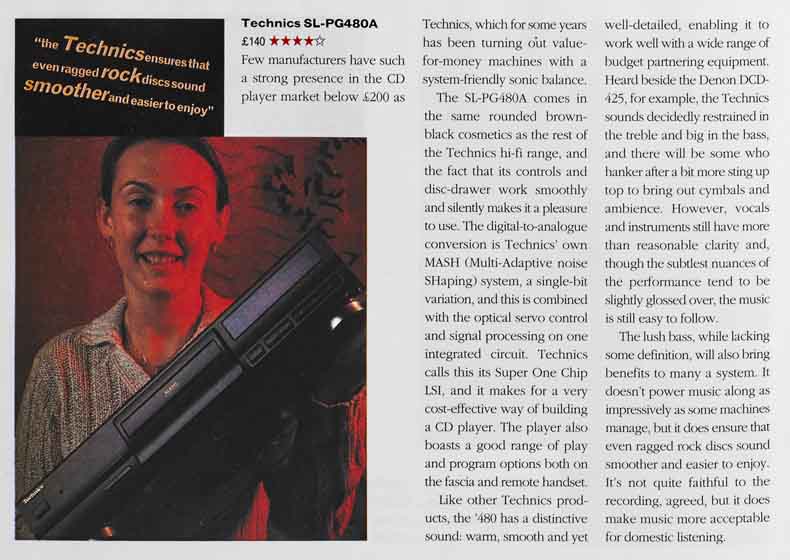
By the mid-’90s, Technics had shown strong form with budget CD players under £200, and the SL-PG480A was another belter.
Aesthetically it stood out with its brown and black look. The build was good, with a generous amount of features accessible on the fascia or by remote.
It had elegantly designed, not to mention cost-effective, internals. From the single-bit MASH DAC to its Super One Chip LS1, it produced a rich and powerful performance without breaking the bank.
The 480 carried over Technics' distinctively smooth, warm and well-detailed sound. Other players were more revealing, but the 480's relaxed performance ensured repeat listens.
Arcam Alpha 7 (1996)
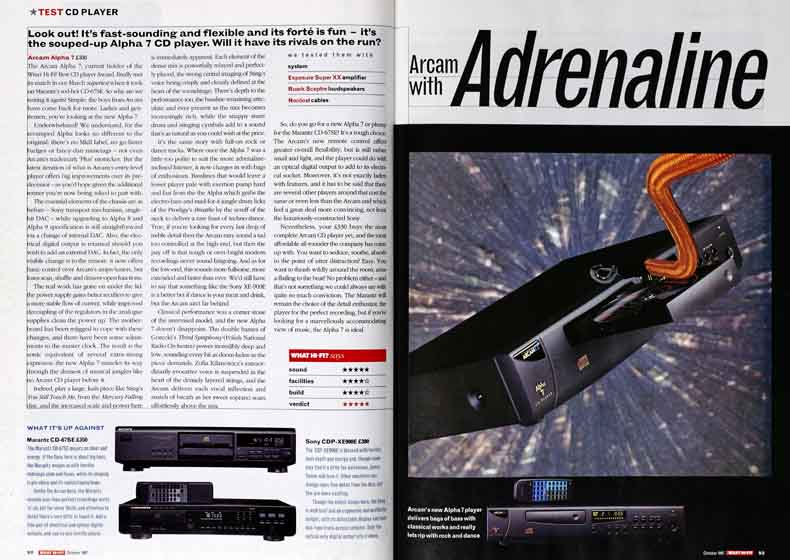
Based on Arcam's landmark Alpha One, the Alpha 7 left the competition in its wake with a What Hi-Fi? Best Buy Award win in 1996.
The Alpha 7 featured a modular design, so an upgrade path was possible. A new DAC board and a badge change meant the Alpha 7 could be transformed into an Alpha 8.
It had a smooth, mature and relaxing sound, which made for a treble that was softer than other players. But the sound had good weight to it, which helped some tracks sound big and substantial.
The Alpha 7 took the game to similarly priced Japanese efforts and held its own. Not many British-made players achieved such a feat.
- Arcam Alpha 7SE makes it to The What Hi-Fi? Hall of Fame: 1990s
Meridian 508.24 (1998)
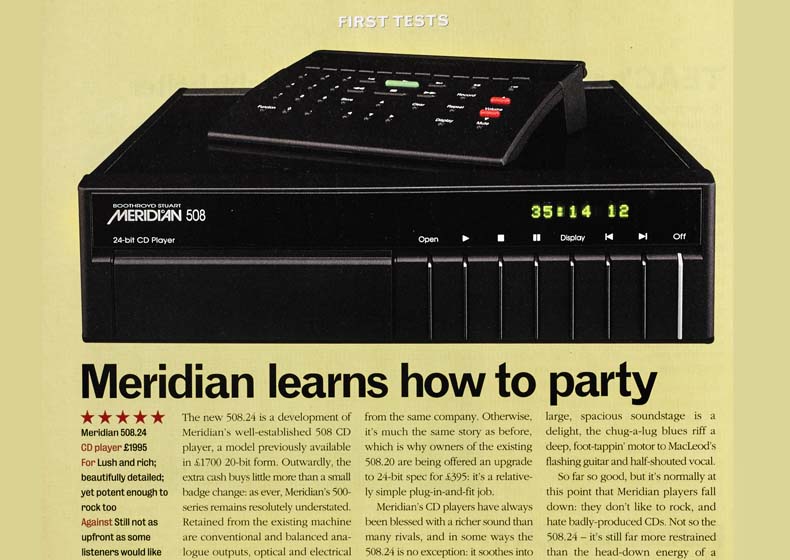
Meridian's 508.24 was an evolution of its 20-bit 508 CD player.
On the outside, the extra cash bought you a badge change. Otherwise, it had the same connections, motorised transport and an almost tablet-sized remote.
The real evolution was the 24-bit upgrade. It continued Meridian's tradition of belting out rich and melodious sound.
Though previous Meridian players faltered in terms of muscularity, the 508.24 liked to rock. It produced a good sense of energy with fast, controlled bass.
Feed it good recordings and the 508.24 was an ideal CD player for those who liked a lush and punchy sound.
Marantz CD-7 (1999)
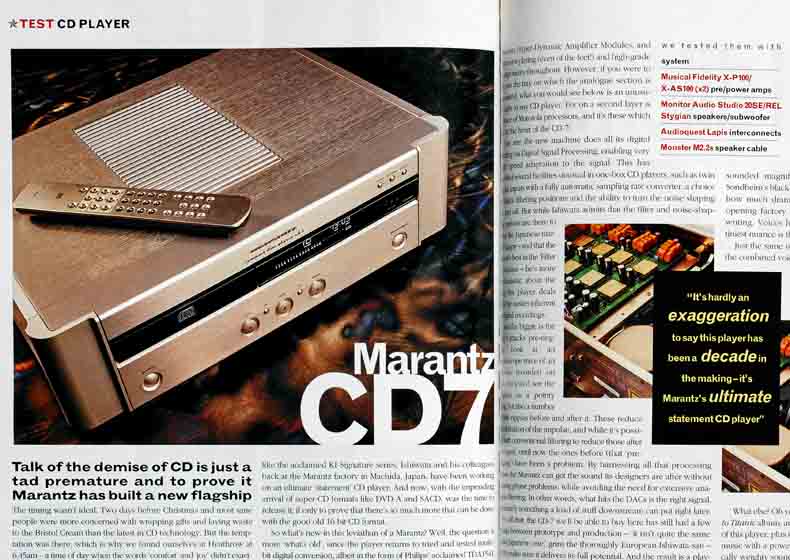
Said to be a decade in the making, the Marantz CD-7 was intended to be the ultimate 'statement' player.
It wasn't so much a vision of the future, but rather an encapsulation of everything the CD format was.
It eschewed single-bit conversion for tried and tested multi-bit, and was full of high-grade components, including Philips’ premium DAC. Even the player's feet had extensive plating.
The CD-7 was capable of real speed and impact. Its weighty sound was substantial, able to drag every bit of nuance from a track. Switching to a lesser player after the CD-7 was a bit of a comedown.
Naim CDS3/XPS2 (2003)
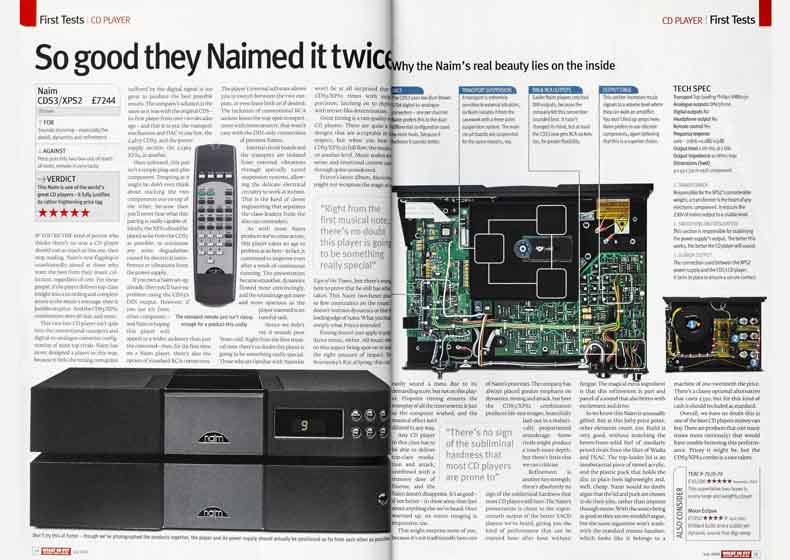
This Naim emerged in 2003 and was a staple of our test rooms for many years.
Made for those who wanted the best sound no matter the price, it was a two-box combo that defied the established wisdom of keeping delicate circuitry separate. Here, the transport and DAC were in one box with the power supply in the other.
It needed a lot of running in – a week! – but delivered a stunning sound with finesse, great timing and attack. When in full flow, the Naim was on another level.
Read our full Naim CDS3/XPS2 review
Quad 99CD-P (2003)
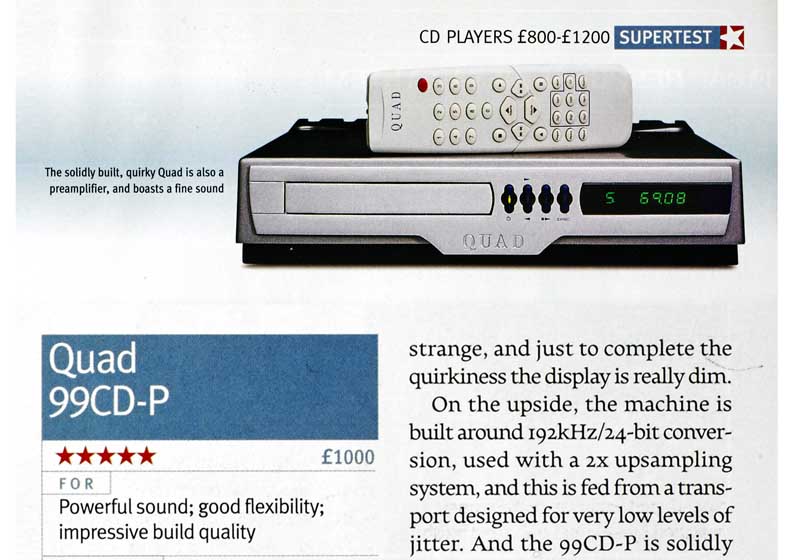
Quad's 99CD-P was a very quirky effort.
Accessing inputs or adjusting the volume could only be done with the remote, and the display was so dimly lit you could barely see what was on it.
It could also be used as a preamp, but only with sources such as a digital recorder or digital radio tuner.
Nonetheless, it was a powerful performer, with plenty of punch and drive but also capable of producing a sense of warmth too.
An odd CD player that summed up the eccentricity of the Quad brand nicely.
TEAC P70/D70 (2003)
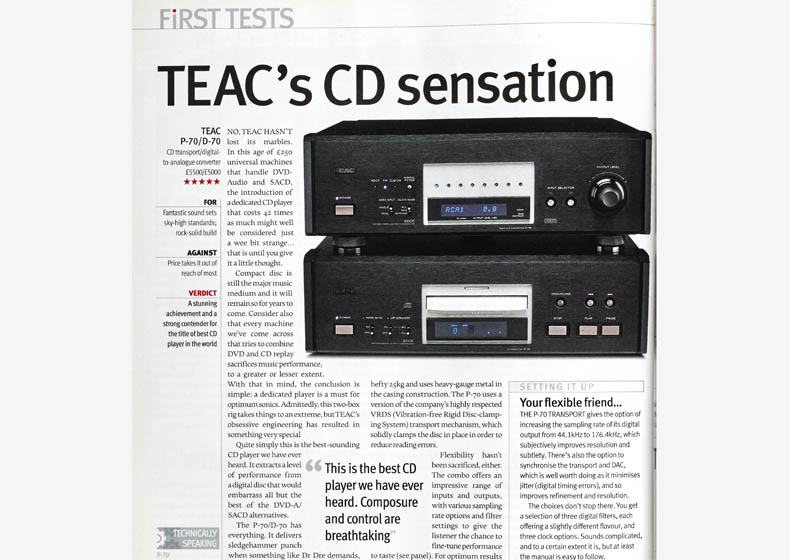
TEAC's P70/D70 combination cost a mighty £10,500 when it launched in 2003 (around £17,000 / $21,000 / AU$31,000 in 2022 money). That sky-high price suggested that TEAC had lost its collective marbles.
It was also indicative of TEAC's ambition to make a great player, and the P70/D70 was the best-sounding player we had heard up to then.
It had everything you could want. There was transparency, neutrality and detail resolution. It packed a sledgehammer of a punch but was able to create a superb sense of space too.
If you could match it with the right equipment, the P70/D70 was an astonishingly good combination.
NAD C521BEE (2004)
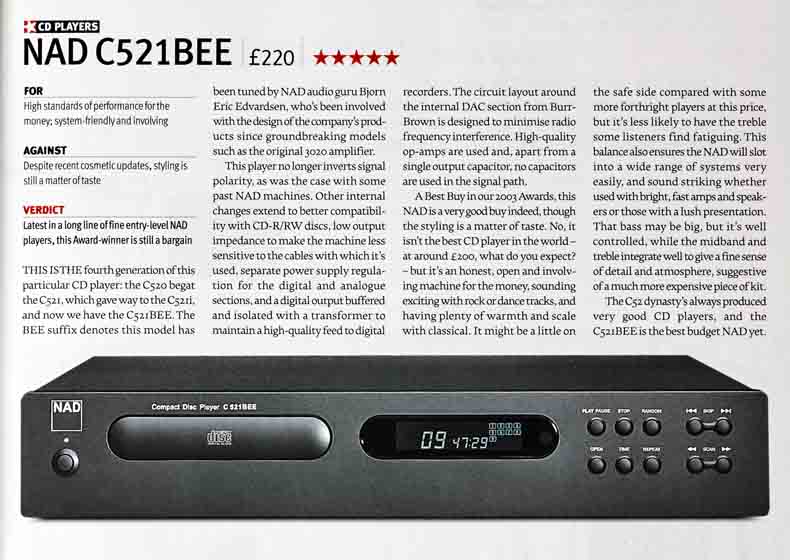
NAD's C521BEE was arguably its best budget effort at the time of its release.
Under its cover, there were a number of changes from its predecessors. It no longer inverted a signal's polarity, the impedance was reduced to make the unit less sensitive, and there was better compatibility with CD-R/RW discs.
The look was plain, but what grabbed your interest was the sound. Honest, open and involving, it perhaps played it safe compared to more forthright players, but its tonal balance meant it could slot easily into a range of systems.
With big but well-controlled bass and a midrange and treble that produced a "fine sense of detail and atmosphere", the CD521BEE's performance belied its budget price tag.
Exposure 2010s (2005)
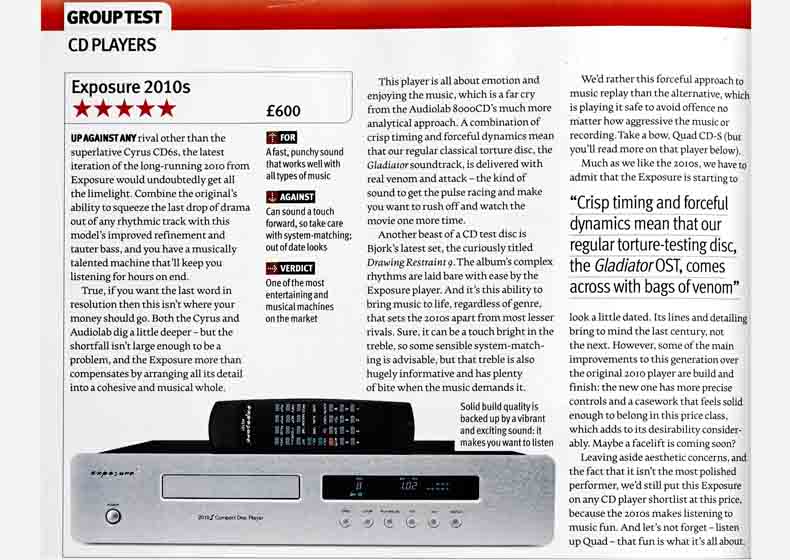
The 2010s had been out a few years, but the version we saw in 2005 was arguably the player's zenith.
It looked dated compared to other CD players, but improvements had been made over the original. The controls on this version were more precise and the casework gave the player more of a desirable sheen.
This player was all about unearthing the emotion from the music. With a fast and punchy sound, it worked well with all kinds of music, laying bare the detail and intricacies within a track.
It made listening to music fun. That's why it was one of the most entertaining and musical players of its time.
Wadia 581ISE (2008)
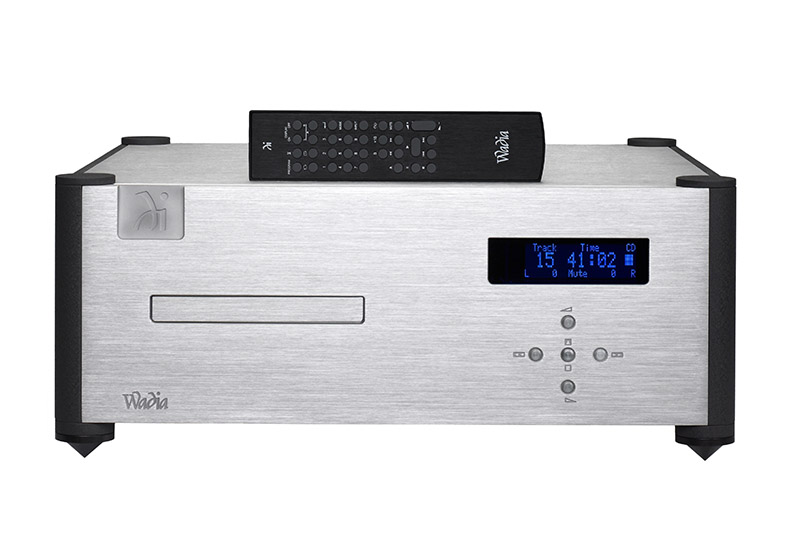
Wadia was known for making the biggest and chunkiest CD/SACD players around, and the 581ISE was no exception.
At 25kg it was a back-breaking effort. It followed Wadia's long-held belief of bypassing the pre-amp. Included were digital controls and variable gain adjustments to match the partnering power amplifier.
The 581ISE's sound was exceptionally cohesive. Timing was convincingly implemented, while bass had breathtaking texture to it and the stereo imaging was superb.
It was too big to easily accommodate, and the imprecise remote and cluttered display were missteps. Despite those issues, few sounded as authoritative or as cohesive.
Read our full Wadia 581ISE review
dCS Scarlatti (2008)
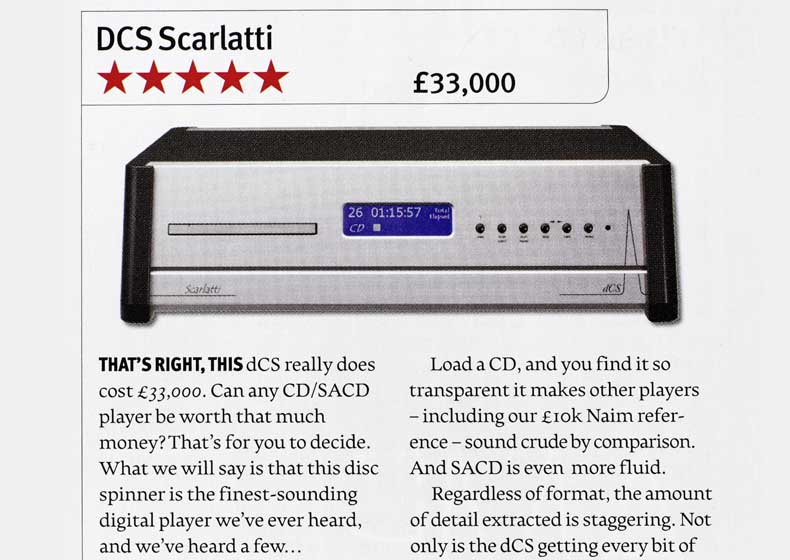
Could any CD/SACD player be worth £33,000 (approx $40,000 / AU$60,000)? dCS' Scarlatti planted its flag in the affirmative.
It wasn't just one box but three: a transport, a DAC and a clock unit. The latter ensured the other two worked in harmony.
Stick a CD in and you were treated to a performance that was as transparent as they came, with staggering amounts of detail and a fine understanding of complex, multi-layered tracks.
A thrilling player, capable of unbelievable sound.
Read our full dCS Scarlatti review
Roksan Caspian M2 (2010)
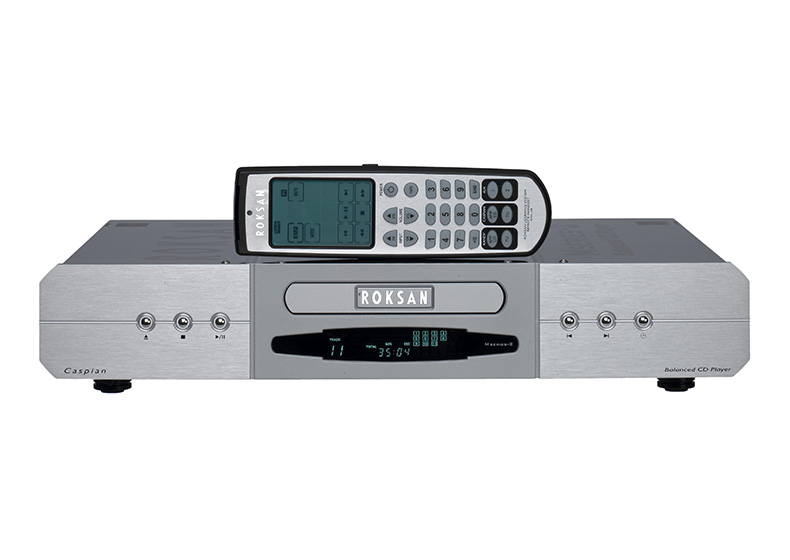
A multiple What Hi-Fi? Award-winner, Roksan's M2 CD was fending off better-spec'd rivals years after it first came out.
That was principally down to how good it sounded. It was full of character, but also combined refinement, bite and rhythmic ability better than any of its closest rivals.
Its build and design certainly facilitated its sonic performance. The CD transport was softly suspended, a move which minimised the "amount of vibration fed into and out of the mechanism".
No other player in its price range could budge it for a long time. A truly captivating performer.
Read our full Roksan M2 CD review
Cyrus CD8 SE2 (2012)
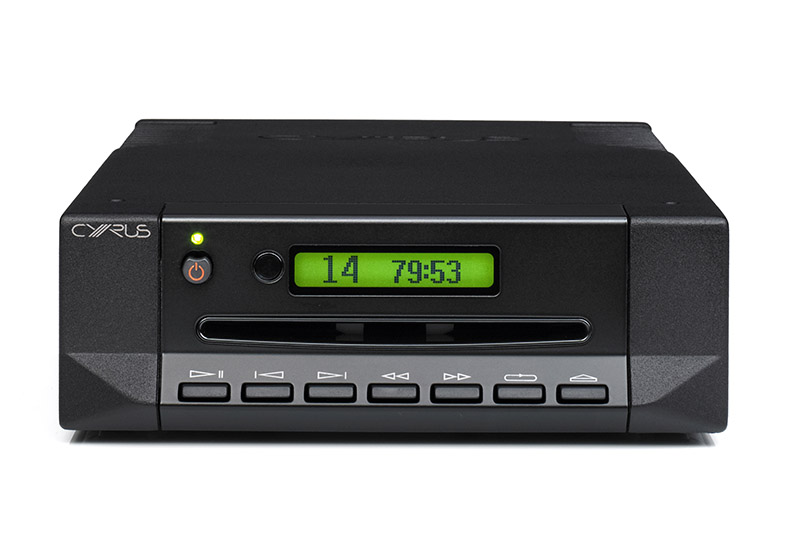
The CD 8 SE2 looked exactly like its original incarnation but brought updates that softened the CD 8 SE's more temperamental nature.
It was less fussy with discs and Cyrus claimed it could more accurately read a compact disc's data. It had an excellent sense of organisation, as well as musicality and punch that were very much in the Cyrus mould.
Like the company's other products, an upgrade path was possible. Slot in the PSX power supply and an extra dose of bass weight, authority and finesse could be extracted.
The CD 8 was stunning. The CD 8 SE2 was even better.
Read our full Cyrus CD 8 SE2 review
Burmester 069 (2013)
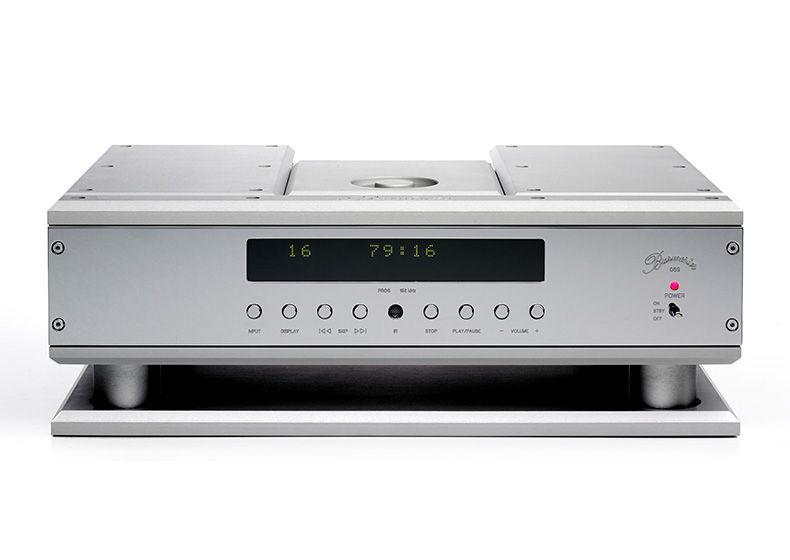
Burmester's 069 deserves to be thought of as one of the best CD players ever.
The German high-end specialist is not known for compromising and that was evident with this player (and its then-£35,000 / $65,000 price!). The immaculate chrome finish and heft of the unit scream high-end hi-fi.
Throw a complicated track at it and the 069 will take it in its stride. Want to go big and loud? The Burmester happily accommodated. It had class-leading composure, with a massive amount of detail on show too.
A wonderfully luxurious player, worth every penny.
Read our full Burmester 069 review
Esoteric K-05 (2014)
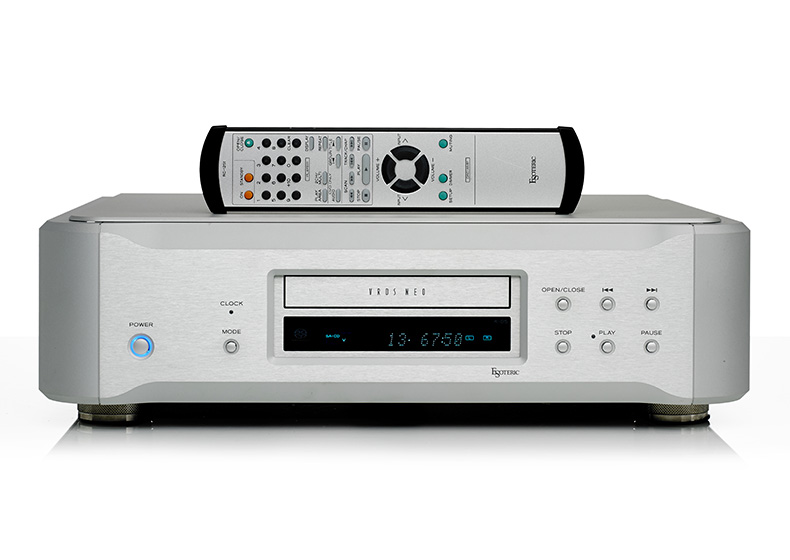
Esoteric's K-05 is a study of obsessive care in construction and design.
Impressively engineered and finished to a high standard, the K-05 is the type of player that looks like it's meant to last forever.
Spin a CD and it was clear why it was heads and shoulders above more ordinary disc spinners. The sound was transparent and detailed, able to communicate a real sense of drive and momentum.
It was expensive but, as an ultimate disc player, better options were few.
Read our full Esoteric K-05 review
Chord Blu MkII (2018)
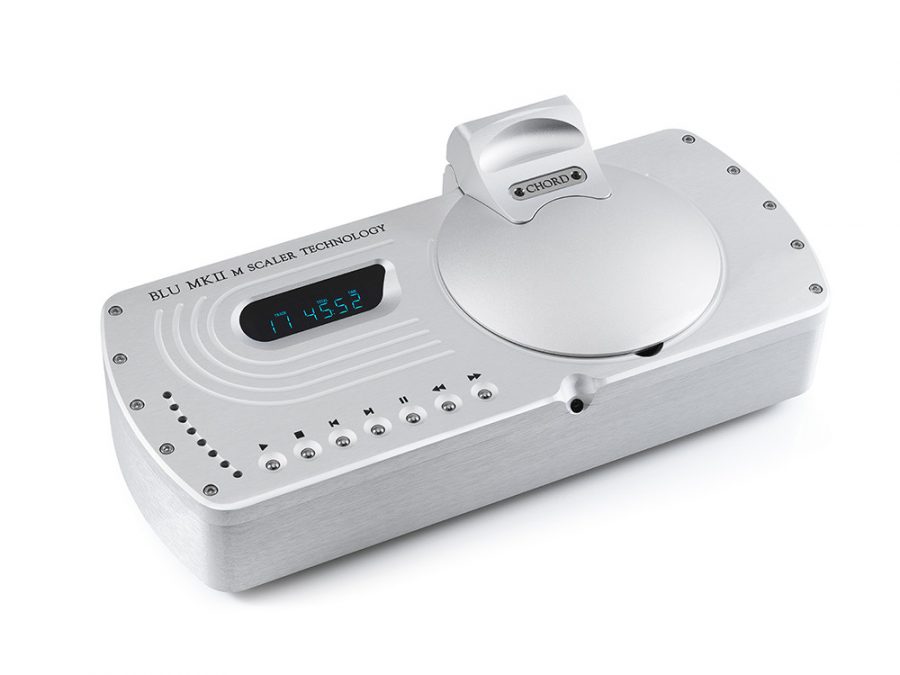
Our penultimate entry is, to quote none other than ourselves, the finest CD transport we've heard.
Inside the MkII is a high-powered upscaler that features lots of clever processing tricks to extract CD's 16-bits of data as accurately as possible.
The end result is a performance that's exceptional at insight and dynamics. It's the most informative sound we've heard from the CD format yet.
Combine it with the Chord's own DAVE DAC and we doubt there's a finer pairing available.
Read our full Chord Blu MkII review
Marantz CD6007 (2020)
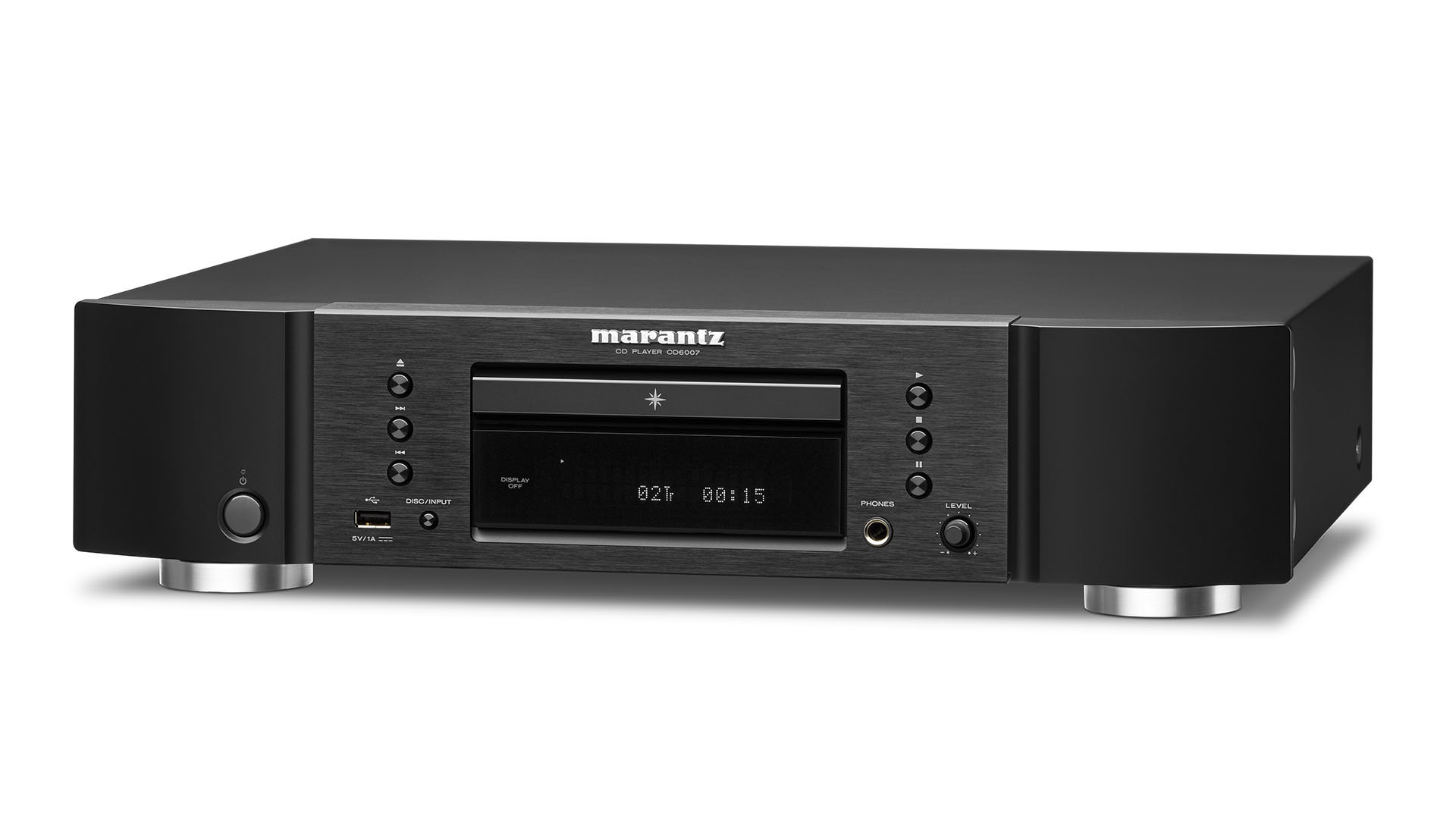
A current What Hi-Fi? Award winner, the Marantz CD6007 is our go-to budget spinner today and its presence on this list represents consistent success for the company's CD6000 range for the past 15 or so years it has existed.
Like its predecessors, the CD6007 offers an exemplary combination of traditional design, broad connectivity and top-notch sound quality at an affordable price. For those who want to keep their CDs spinning in a budget to mid-range system, it is a choice pick indeed.
Read our full Marantz CD6007 review
Check out more 'best of' lists:
The best 19 stereo amplifiers of What Hi-Fi?'s lifetime
What Hi-Fi?, founded in 1976, is the world's leading independent guide to buying and owning hi-fi and home entertainment products. Our comprehensive tests help you buy the very best for your money, with our advice sections giving you step-by-step information on how to get even more from your music and movies. Everything is tested by our dedicated team of in-house reviewers in our custom-built test rooms in London, Reading and Bath. Our coveted five-star rating and Awards are recognised all over the world as the ultimate seal of approval, so you can buy with absolute confidence.

